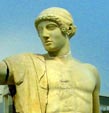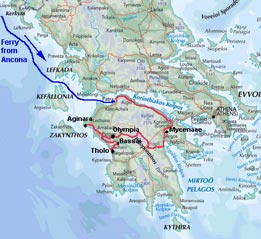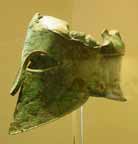OUR GREEK ODYSSEY - Week 3

Week 3 Photos Bottom of page
Return to Index-page
|
We drove west into central Arcadia to re-visit the remains of ancient Mantineia, set in a broad flat valley surrounded by snow-capped mountains - no wonder Homer called it "pleasant Mantineia". Continuing westwards into the Arcadian mountains, we searched for the site of ancient Orchomenos. High on a tree covered hilltop, 3,000 feet above the surrounding valley, we found the remains of the city's theatre built into the steep hillside. Photo 1 shows the view that spectators would have enjoyed. Homer called Orchomenos "rich in sheep" and we saw a number of shepherds minding their flocks. Unlike their mythological counterparts, modern day Arcadian shepherds now ride in Datsun pick-ups rather than on donkeys, and instead of playing pan-pipes, they smoke Marlboro cigarettes. Beyond here, the narrow road wound its way over the highest area of mountains and down into the Alpheios valley where we camped at Ancient Olympia. The town exists today to sell tacky souvenirs, obscene postcards and over-priced schmuk to the 1000s of tourists who daily visit the site of the ancient Olympic Games. These began in 776 BC as part of the religious festival to Olympian Zeus, the remains of whose temple still dominate the archaeological site. The enormous temple was built in 456 BC to house the 40 feet high gold and ivory cult statue of Zeus, one of the 12 wonders of the ancient world. The mighty Doric columns which surrounded the temple now lie strewn across the ground where, after standing for 1000 years, they fell when an earthquake destroyed the structure in 6th century AD. The other key attraction are the excavated remains of the classical Olympic Stadium, where 45,000 spectators once sat on the surrounding grassy banks to watch the events. For us, the greater interest was the Archaeological Museum which displays the rich finds from the area. In the ancient world, such was the prestige of the Olympic sanctuary that city-states from around Greece would make dedicatory offerings to Zeus, commemorating victories in war or successes in the Games. The most famous of such offerings is the helmet worn by the Athenian general Miltiades at the battle of Marathon in 490 BC, inscribed with his name, and dedicated to Zeus in thanks for victory over the invading Persians (see photo at foot of page). We spent much of the day wandering happily among the excavations at Olympia, which at this time of the year are brightened by the pink blossom of Judas trees (Photo 2). After such a hectic period, we treated ourselves to a day's R & R down at the coast, and camped at Aginara Beach on the NW corner of the Peloponnese, opposite the island of Zakynthos. We pitched within 50 m of the wild deserted beach, and the air was constantly filled with the roar of crashing surf and the songs of birds in the surrounding trees - it was truly beautiful (see photo 3). But duty called; it was time to head back into the mountainous interior, in order to visit one of the best preserved of classical temples. We were uncertain however of the state of roads in the area. Once off main routes, minor roads in the mountains are often unsurfaced dirt-tracks. Even main roads are unpredictable - there's no pot-hole like a Greek pot-hole! So we assigned 2 days for this venture. The first day, we travelled 50 miles up into the mountains, both to investigate the state of roads and to explore a beautiful hilltop town called Karitsaina. Over its 1,400 years of history, the town has been occupied by Byzantine Greeks, Frankish Crusaders and Turks, and became a centre of Greek resistance to Turkish occupation during the Greek War of Independence in 1821. The old town is overshadowed by a 13th century Frankish castle built on a rocky prominence, and in pre-Euro days, the town's mediaeval bridge figured on the Greek 5,000 drachma note. That night, we 'wild camped' just outside Andritsaina, another remote town perched high on a mountainside, close to the temple we wanted to visit. The temple of Bassai was built at a remote sacred cult-site by the inhabitants of Phigaleia, an ancient settlement on the NW side of the Messinian mountains (a village of this name still exits today). It was dedicated to Apollo Epikourios ('Protector') in gratitude for the city being spared from the plague in 430 BC. So grateful were the Phigaleians to their protecting deity that, although only poor mountain farming folk, they hired the best architect of the day, Ictinos from Athens (who also designed the Parthenon), but they could only afford to use local limestone, not posh marble. The result is startling. The temple, set on a shoulder of wild and remote Mount Kotilion at 3,700 feet, survived in remarkably good condition despite extremes of weather, occasional earthquakes and pillaging by 18th century Brits who sold the temple's carved frieze panels to the British Museum where they remain. Today the surviving remains are swathed in a protective tent-like canopy, as part of a programme of restoration. We drove up the 14 kms of narrow winding mountain road from Andritsaina where we had over-nighted, and around the final bend, there was the enormous grey 'tent' perched on the mountain side. Although regretted by many, without this protection, the ancient structure would probably have collapsed by now (see photo 4). Having satisfied ourselves of the state of the road leading on from the temple, we followed this for another 42 kms winding through the mountainous territory of the Phigaleians down to the coast, and again camped within 100 m of a wild beach at Tholo, hoping to see the turtles which nest along the Peloponnese's western coastline - no such luck yet however. What an amazing week of contrasts - between mountains and wild unspoilt coastline. Sheila's botanical studies have already outstripped all expectations. Our memories of the week are dominated by the experience of visiting the temple of Apollo at Bassai, high up in the Messinian mountains at such a remote location. We shall now be moving on further south, down the west coast to camp at Homer's 'sandy' Pylos - more on this next week. Sheila and Paul Published: Friday 23 April
|
 Week 3 news: Elis and Messinia
- coast & mountains
Week 3 news: Elis and Messinia
- coast & mountains